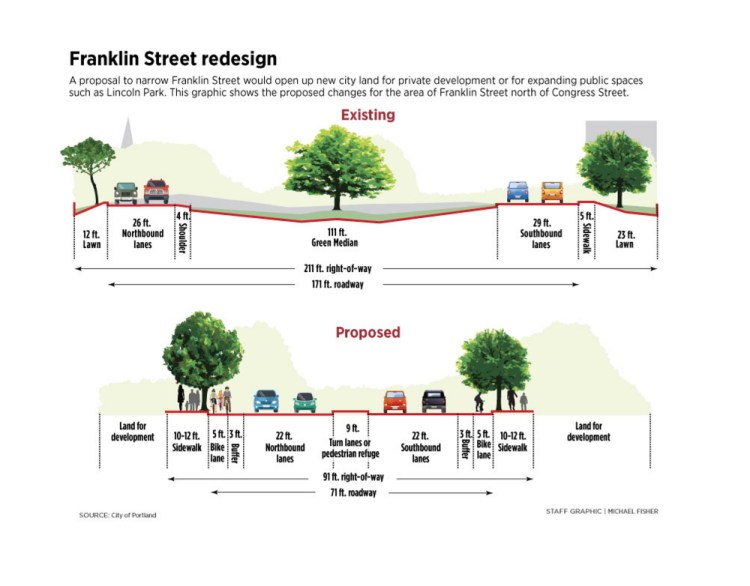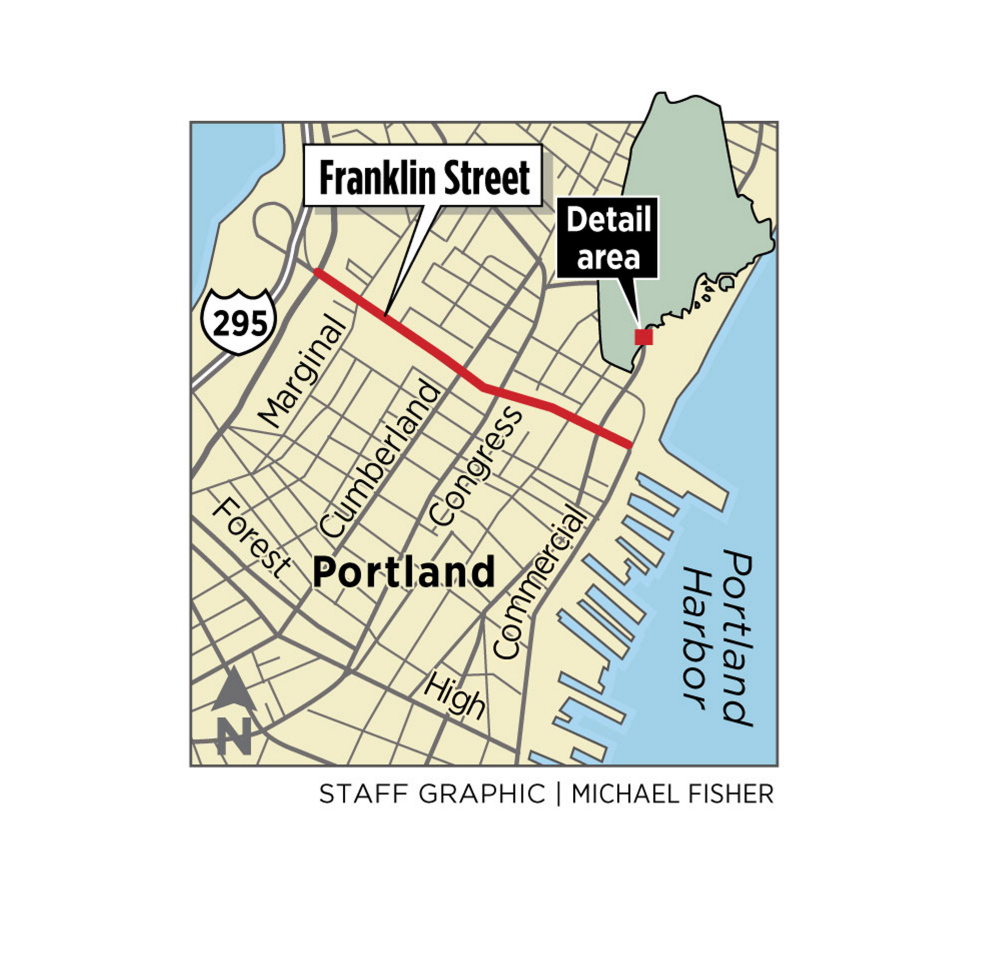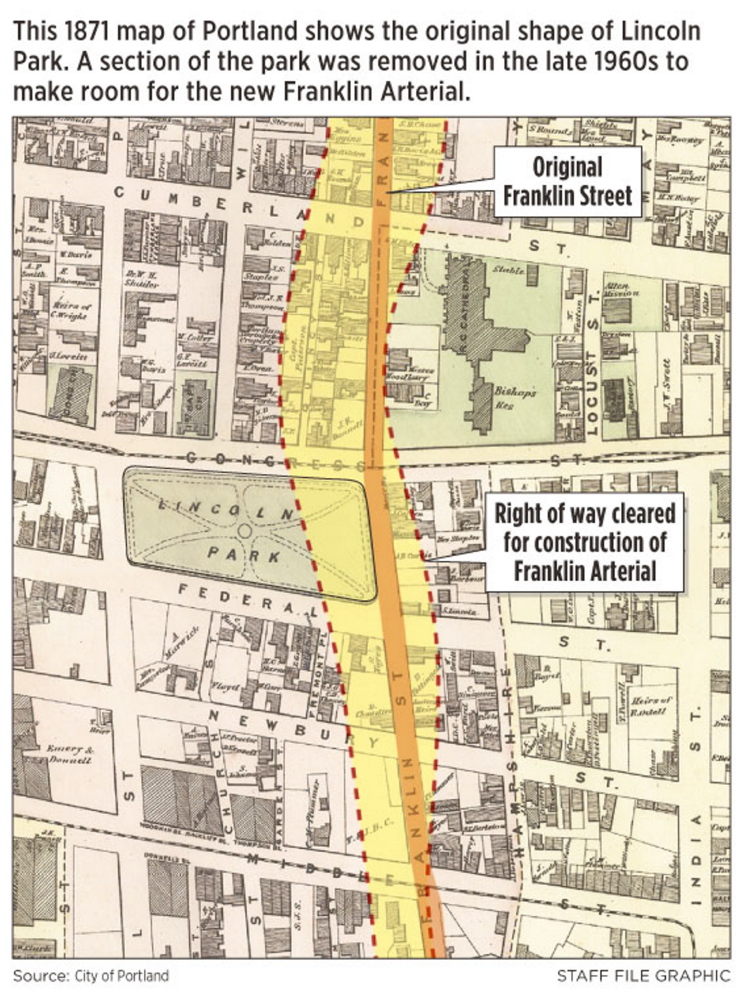Four women got out of a cab Tuesday afternoon outside Eventide Oyster Co., hoping to pop into a few of the boutiques they’d heard about.
Instead, the cruise ship passengers from upstate New York stood dumbfounded as they looked across Franklin Street toward the Old Port. It looked more like a highway than a spot for window-shopping, they said.
For nearly 45 years, Franklin Street’s four lanes of traffic and wide grassy median have served as an intimidating, high-speed barrier dividing the city’s downtown.
But it might not stay that way for long.
The latest plan to reconfigure the three-quarter-mile route connecting Interstate 295 with Portland’s waterfront would remove the wide median, reduce the number of travel lanes between Congress and Commercial streets and shrink the width of the corridor, opening up land on both sides for potential redevelopment. The plan, which will be unveiled at a workshop Wednesday, also calls for a buffered bike lane, wider sidewalks and better pedestrian crossings.
The changes are meant to improve safety, reconnect the east end of the peninsula with the central downtown and open space for new development – reversing the destruction of neighborhoods and the division of the city that made way for the arterial when it opened in 1970.
At the time it was built, Franklin was intended to make it more convenient for vehicles to travel in and out of Portland in the hope that would draw more economic development into the city, which was losing out to suburban shopping malls.
Sidewalks weren’t installed along the arterial purposely to keep pedestrians away. There was even a plan to have two additional travel lanes in the center of the corridor that would go underneath Cumberland Avenue and Congress Street to avoid traffic lights. The project ran out of money before those lanes were built, which is why the median is so wide today.
“It’s a little bit of a disconnect, a little bit of a no-man’s land,” said Markos Miller, co-chairman of a public advisory committee for the redesign of Franklin Street.
The idea now is to weave Franklin Street back into the fabric of the city, creating a new downtown destination instead of just an easy way out.
The narrowing of the corridor would potentially open up acres of pavement to potential private development. Given the hot real estate market on the city’s East End, some have speculated the land could top $1 million an acre on the market.
The selling points of the plan also may include additional open space, namely a larger Lincoln Park, a quarter of which was chopped off by the construction of the arterial. The advisory committee hasn’t settled on whether to restore more of the park or to reserve extra space across the street for new development.
That’s one area in which public comment Wednesday could influence the end result. The workshop starts at 5:30 p.m. at the Portland Public Library.
In the coming months, the committee will finalize its recommendation to the City Council and plans to have a preliminary design done in the spring, said Carol Morris, who is helping coordinate communications and public outreach for the project. The committee expects to have cost estimates when preliminary designs are completed.
Aaron Shapiro, who crosses Franklin Street from his office on Federal Street about once a week, thinks there are more pressing improvements needed in the city, pointing Tuesday to the cracks in the concrete and run-down benches in Lincoln Park.
Shapiro believes the problem with Franklin Street isn’t the size, but the system for letting pedestrians cross. Even when it’s their turn to walk, he said, they have to watch for cars going right on red. And people tend to scoot across when “don’t walk” signs are lit, if they think they can make it in between vehicles that often exceed the posted 35 mph speed limit.
That was evident around lunchtime Tuesday when a steady stream of people made their way across Franklin Street between Fox and Somerset streets.
Some sauntered across when traffic was slow. Alba Briggs scurried to beat oncoming cars.
Briggs, who works at Performance Building Supply, crosses the intersection every day, before and after getting lunch at Whole Foods.
“There’s a lot of traffic, so I understand I’m going to have to wait,” he said.
Briggs’ bigger gripe is with crossing the street closer to the center of town. To get to his bank, he walks up the grassy shoulder on Franklin Street, where there’s no sidewalk, and darts across the street when he can, walks down the dip in the wide grassy median and up the other side, then waits for traffic to subside to make his way across.
He doesn’t mind it that much, but imagines other people might have a harder time.
“It really makes sense to make it easier to cross,” he said.
Copy the Story LinkSend questions/comments to the editors.







Success. Please wait for the page to reload. If the page does not reload within 5 seconds, please refresh the page.
Enter your email and password to access comments.
Hi, to comment on stories you must . This profile is in addition to your subscription and website login.
Already have a commenting profile? .
Invalid username/password.
Please check your email to confirm and complete your registration.
Only subscribers are eligible to post comments. Please subscribe or login first for digital access. Here’s why.
Use the form below to reset your password. When you've submitted your account email, we will send an email with a reset code.